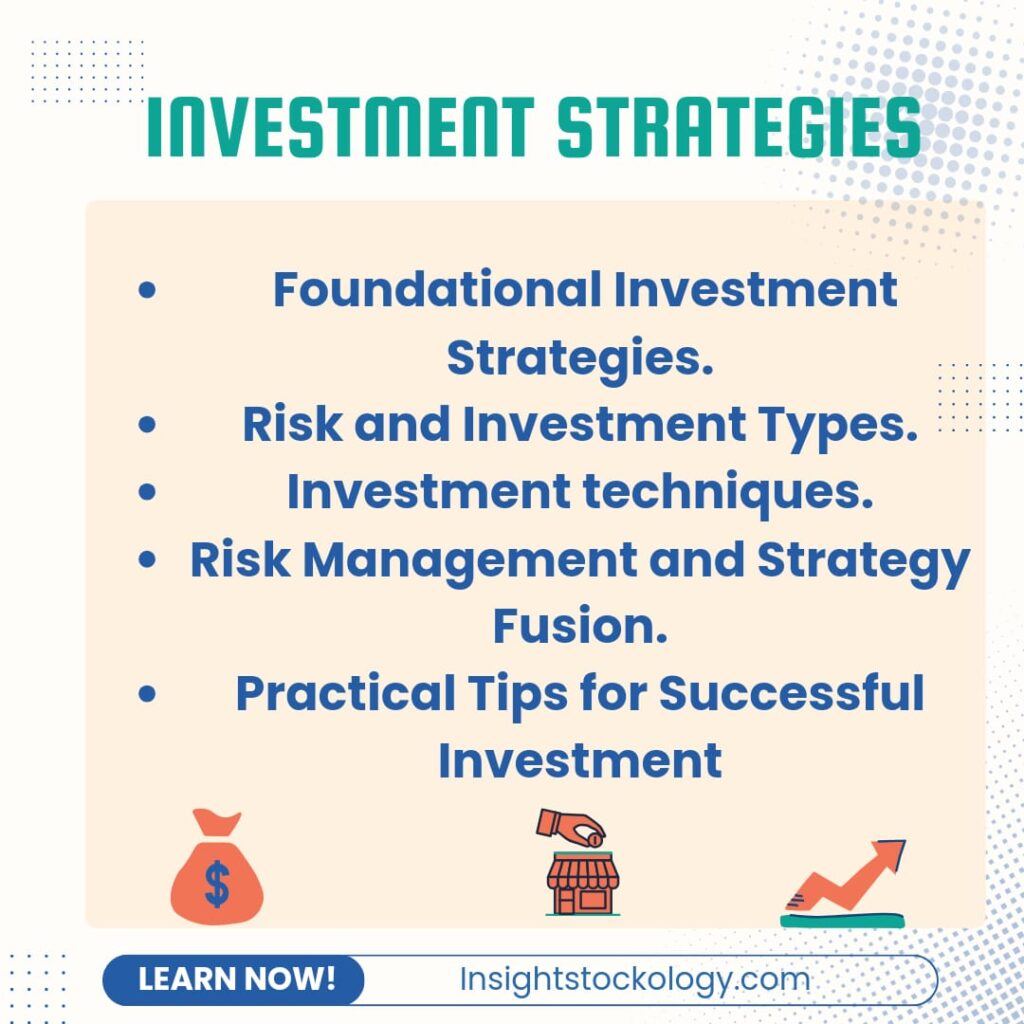Welcome to Insightstockology.com, in today’s blog, we are gonna discuss about ‘Top 5 Best Investment Strategies Learn Before Invest- For Beginners 2024‘ that can guide you towards your financial goals.
Getting started with investing can feel like a thrilling ride, often thought to be only for the wealthy or compared to gambling. It usually kicks off with the excitement of making your first stock purchase. While many beginners being with mutual funds for their perks like diversity and expert management.
Understanding investment strategies is like knowing the rules guiding your investment decisions. These strategies act like paths leading to your financial goals. These strategies act like paths leading to your financial goals. They’re flexible, letting you choose based on how much risk you’re comfortable with, your investing preferences, financial goals, and the money you have to invest. It’s important to know that changing your strategy comes with a cost.
Investment managers, who have different ways of doing things called ‘Investment Strategies’, are key players in shaping portfolio goals. They might adjust their strategies based on what’s happening in the market, using a mix of styles to handle future risks and rewards.
IMPORTENT HIGHLIGHTS
- Begin your strategic planning by assessing your financial status and setting clear goals.
- Engage in value investing with a commitment to long-term involvement, dedicating time and research to stock selection.
- Growth-focused investors need to stay vigilant about executive teams and stay informed about economic developments.
- Investors embracing momentum look to purchase stocks on the rise and may opt for short selling under specific conditions.
- Practice the systematic approach of dollar-cost averaging by consistently investing in the market over an extended period.
Table of Contents
Top 5 Best Investment Strategies Learn Before Invest.

Section 1: Foundational Investment Strategies.
- Value Investing:
Choosing stocks that seem to be trading below their true or book value characterizes Value Investing. This strategy involves investors actively searching for stocks they believe the market has undervalued. These investors hold the view that the market tends to react excessively to both positive and negative news, causing stock prices to deviate from a company’s fundamental worth.
This exaggerated market reaction creates an opportunity to benefit from purchasing stocks at discounted prices. Value Investing is particularly suitable for those aiming to hold onto their investments for an extended period. When investing in value companies, one should anticipate that their businesses may take a few years to fully develop. Value Investing embraces a comprehensive strategy, often likened to a “slow but steady” growth mindset.
The foundation of this approach lies in the market’s tendency to overreact to news, leading to significant fluctuations in stock prices that may not align with a company’s long-term prospects. Investors employing this strategy buy stocks when prices are low and sell when they rise.
2. Income Investing:
Income investing is a strategic approach to building a portfolio that prioritizes a steady stream of earnings. This method focuses on generating ongoing cash flow rather than relying solely on capital gains from selling holdings. Investors embracing income investing aim to create financial stability, making it a viable strategy for both retirement planning and throughout various stages of life.
In simpler terms, income investing means setting up your investments to regularly produce income. This can come from dividends in stocks, interest from bonds or savings accounts, or other assets like real estate. The key is creating a reliable cash flow.
3. Growth Investing:
Growth investing focuses on boosting investors equity through ‘growth stocks’., typically small businesses with anticipated rapid expansions. This strategy thrives in specific economic conditions, suitable for those seeking short-term gains. However, it involves higher risk, particularly during economic downturns. Unlike value investing, growth investors prioritize a company’s future earning potential over low-cost deals, aiming for the “next big thing”. While growth lack dividends and face higher valuations, a strategic fusion of growth and value investing can optimize return and mitigate risk across economic cycles.
4: Active Investing:
Active investing involves actively managing portfolios by analyzing stock movements frequently, aiming for short-term profits. Unlike passive investing, where stocks are held for long-term appreciation, active investors use strategies like swing trading for short-term opportunities. This approach allows for quick adjustments in response to market conditions, minimizing risks during crises.
The benefits of active investing include the potential for higher risk-adjusted returns, flexibility in stock selection, and tax management. Actively managed portfolios aim to outperform market indices, seizing undervalued opportunities and swiftly divesting from underperformers. This flexibility also allows for strategic waiting periods, optimizing investment opportunities.
In summary, active investing provides a chance for greater rewards through dynamic portfolio management, emphasizing quality factors. Flexibility in stock choices and tax management strategies further enhance the appeal of this approach.
5: Passive Investing:
Passive investing is a straightforward strategy that emphasizes a buy-and-hold mentality, designed for long-term investors. The primary aim is to benefit from the overall market’s gradual increase in prices over time. An easy way to implement this approach is through index funds, such as those tracking the S&P 500 index. These funds automatically adjust their holdings based on changes in the index constituents.
Passive investors avoid frequent buying and selling, reducing transaction costs. The strategy’s simplicity lies in tracking an index, eliminating the need for expert stock analysis. The potential benefits of passive investing include ease of understanding, low costs due to minimal trading, and historical long-term growth in major indices.
However, passive investing has limitations. It lacks the flexibility to respond to short-term market changes and restricts choices to the stocks within the selected index. Despite this, successful passive investors focus on the long-term, ignoring temporary setbacks and capitalizing on the overall upward trajectory of corporate profits in the market.
Section 2: Risk and Investment Types.
- Momentum Investment:
Momentum investing centers on seizing trends: buying stocks on the rise and short-selling those in decline. Technical analysts guide decisions, relying on data-driven insights. Unlike the efficient-market hypothesis, momentum investors believe recent changes aren’t fully factored into prices. The appeal lies in potential gains; for instance, the MSCI World Momentum Index outpaced its benchmark, averaging 10.75% gains annually since 1994 through 2022 June, compared to 7.59% over the same period. Despite debate among experts, momentum investing capitalizes on established trends, with some seeing it as a strategic play on behavioral biases like the ‘herd mentality’.
2. Index Investment:
Index investing offers a straightforward and passive approach to wealth building. Unlike active strategies, it requires minimal effort from investors. By mimicking the performance of major stock indices like the S&P 500, this method ensures broad diversification and attempts to mirror overall market returns. Studies consistently show that, over the long term, few individual stock-picking strategies outperform index investing. This strategy involves buying into mutual funds or ETFs that closely track renowned indices, promising simplicity, lower costs, and the potential to outshine active management.
3. Low-Risk Investment:
Low-risk investments involve minimal potential loss, either in invested amount or portfolio significance. The aim is to safeguard against significant losses, ensuring they won’t be financially devastating. It revolves around protecting capital and managing expectations.
4: High-Risk Investment:
High-risk investments come with a substantial chance of capital loss or underperformance, possibly leading to severe financial setbacks. This risk is quantified either by a substantial percentage chance of loss or the likelihood of a significant negative impact on expected returns. Understanding these distinctions helps investors navigate the balance between risk and potential gain.
Section 3: Investment Techniques.
- Buy and Hold:
A powerful investment approach, buy and hold entails purchasing assets and holding them indefinitely, ideally for 3 to 5 years. This strategy fosters a long-term mindset, steering clear of the pitfalls of active trading. By focusing on the underlying business’s performance over time, investors can uncover substantial gains, potentially multiplying their original investment. The beauty lies in simplicity: committing to never sell means avoiding capital gains taxes. While enduring market fluctuations is a challenge, this passive strategy allows investors to enjoy life rather than being tethered to constant market monitoring.
2. Buy Index Fund:
Investing in an index fund involves buying into a diverse collection of stocks that mirror popular indices like S&P 500 or Nasdaq. This passive strategy allows you to own a slice of the market without the hassle of analyzing individual stocks. By adopting a buy-and-hold mentality, you can enjoy the average returns of the index. While it reduces risk through diversification, patience is key for long-term success. Index funds provide a straightforward and low-effort way to benefit from market growth, making it an accessible option for investors seeking simplicity and consistent returns.
3. Dollar-Cost Averaging:
Dollar-cost averaging (DCA) is a smart investment strategy where you consistently invest a fixed amount at regular intervals, smoothing out market volatility. This method isn’t exclusive and complements other investment approaches. By automating your contributions, DCA helps you avoid the risky game of market timing. It allows you to capture prices at various levels, from highs to lows, lowering the average cost per share and potentially reducing future taxable basis. This disciplined approach is particularly powerful, offering a steady way to accumulate wealth over time while mitigating the impact of short-term market fluctuations.
4. Quantitative Analysis:
Quantitative analysis exclusively focuses on numerical data and does not impact a company’s day-to-day operations. Even though fundamental analysis incorporates numeric elements, the primary emphasis lies in qualitative aspects such as managerial skills, competitive landscape, market potential, substitution possibilities, and more.
For a quantitative analyst, these factors are considered as supporting subjective judgment rather than the primary influencers for buy/sell decisions. With the evolution of technology, computational tasks are predominantly executed through computers and tools. Quants, as analysts are commonly known, now rely solely on buy/sell signals derived from quantitative criteria, without considering managerial aspects or the actual business itself.
5. Screen-Based Analysis:
Quantitative analysts employ “screens” to conclude their investment decisions. These screens seek patterns and sift through companies aligning with specific criteria. Various factors about a company’s operations or stocks can be explored through screens.
Moreover, screens often serve as idea generators, followed by the application of either fundamental analysis or technical analysis models to each potential investment before arriving at a final decision. According to investors, the utilization of screens helps eliminate emotional biases from the investment process.
6. Fundamental Analysis:
Fundamental analysis involves evaluating a company’s value when buying its stock. It’s like determining the worth of a share you’re considering. Unlike random decisions, fundamental analysis calculates this value by assessing economic, financial, and managerial factors. In simpler terms, it gauges the investment’s intrinsic value based on the company’s performance, industry conditions, and overall economy. The goal is to compare this calculated value with the current market price to decide if the stock is undervalued or overvalued by others. Essentially, fundamental analysis helps investors make informed decisions by understanding a company’s true worth.
7. Technical Analysis:
Technical analysis, a method for evaluating investments, relies on charts and psychological data to identify trading opportunities. In this discipline, investors analyze statistical trends like price movements and volume, seeking patterns that signal potential buy or sell decisions. Unlike fundamental analysis, which assesses a security’s value based on business results, technical analysis focuses on studying price and volume dynamics. In a market where information isn’t always instantly available, charts provide valuable insights into the psychology surrounding a stock, enabling investors to make informed decisions based on observable trends.
Best Tools For Fundamental & Technical Analysis – Trickertape
Section 4: Risk Management.
- Investment Diversification:
Diversification, a key strategy in managing investment risk, aligns with the wise saying ‘Don’t put all your eggs in one basket.’ Instead of concentrating your funds on a few stocks, spreading investments across various sectors safeguards against significant losses during market downturns. This risk management approach involves creating a portfolio with a mix of different assets and investment types, aiming to achieve higher long-term returns while minimizing exposure to individual risks. In essence, diversification acts as a protective shield, reducing the likelihood of all investments underperforming simultaneously.
2. Practice Goal-Based Investment:
Goal-based investing is a modern wealth management strategy centered around achieving specific life objectives. Instead of solely focusing on maximizing portfolio returns, this approach directs attention to measurable goals like funding your child’s education or building a retirement nest egg. By identifying your goals, you can tailor your investments accordingly. For example, if saving for a car is your priority, consider investing in a mix of equity and debt through online mutual funds. Goal-based investing provides clarity, ensuring you make informed choices aligned with your aspirations.
Section 5: Practical Tips for Successful Investment.
1. Invest Only in What You Want:
Investing wisdom emphasizes understanding a company’s business model before committing capital. If a company’s business model is unclear, it’s prudent to avoid investment. Warren Buffett’s Rule 1 urges investors not to lose money, highlighting the importance of cautious decision-making. Rule 2 reinforces this, advising investors to remember Rule 1. Buffett’s 2008 financial crisis losses underscore the need for an informed, serious approach. Investing without a grasp of a company’s business model is risky, potentially leading to capital loss. In essence, investing in what you comprehend reduces risks and aligns with Buffett’s fundamental rules.
2.Re-balance Your Portfolios When Needed:
Regularly monitoring and adjusting your investment portfolio is crucial for achieving your financial goals. Over time, the values of your assets may shift, leading to an imbalance. Rebalancing involves realigning your portfolio by buying or selling assets to maintain your desired mix, such as between equity and debt. This ensures your risk profile stays in line with your objectives. Keep in mind the tax implications when selling profitable investments. While the frequency of rebalancing depends on factors like age and risk tolerance, it’s generally recommended to rebalance at least once a year for optimal portfolio management.
Summary.
Entering the investment world requires a strategic approach. Whether you seek income, aggressive growth, or a balanced mix, understanding these diverse strategies empowers you to make well-informed decisions. Remember, success lies not just in what you invest in but how you tailor your approach to align with your unique financial objectives.









4 thoughts on “Top 5 Best Investment Strategies Learn Before Invest- For Beginners 2024”